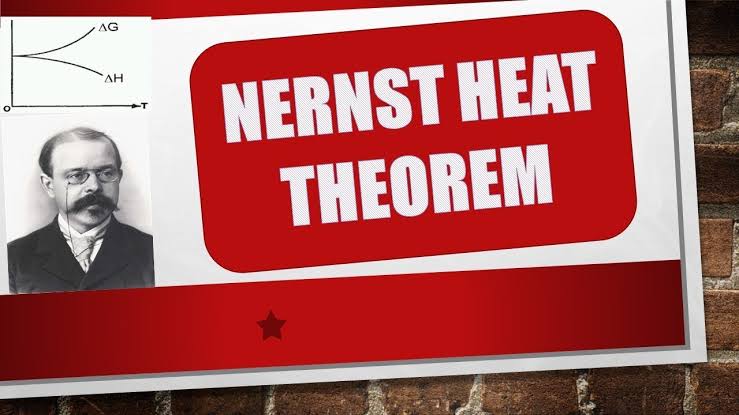Nernst Heat Theorem – Chemistry Notes – For W.B.C.S. Examination.
Chemistry is one such optional offered in the W.B.C.S. Examination. It is one of the optional subjects that is preferred by the aspirants graduated with the subject. Chemistry optional is a scoring subject if aspirants have sound knowledge in it. Similar to other optional papers, chemistry also has two papers. The paper I of chemistry optional deals with Inorganic Chemistry and Physical Chemistry. Paper-II completely deals with Organic Chemistry.Following previous years question papers are a must when it comes to optional subjects.The third law arises in a natural way in the development of statistical thermodynamics. It is probably fair to say that the classical thermodynamic treatment of the third law was shaped to a significant degree by the statistical thermodynamic treatment that developed about the same time. Nevertheless, we can view the third law as an inference from thermochemical observations.Continue Reading Nernst Heat Theorem – Chemistry Notes – For W.B.C.S. Examination.
Walther Nernst was the first to recognize the principle that underlies the third law. From published experimental results, Nernst inferred a postulate known as the Nernst heat theorem. The experimental results that inspired Nernst were measurements of enthalpy and Gibbs free energy differences, <span id=”MathJax-Element-1-Frame” class=”MathJax” style=”font-style: normal;font-weight: normal;line-height: normal;font-size: 17.6px;text-indent: 0px;text-align: left;text-transform: none;letter-spacing: normal;float: none;direction: ltr;max-width: none;max-height: none;min-width: 0px;min-height: 0px;border: 0px;padding: 0px;margin: 0px” role=”presentation” data-mathml=”ΔrH”>ΔrHΔrH and <span id=”MathJax-Element-2-Frame” class=”MathJax” style=”font-style: normal;font-weight: normal;line-height: normal;font-size: 17.6px;text-indent: 0px;text-align: left;text-transform: none;letter-spacing: normal;float: none;direction: ltr;max-width: none;max-height: none;min-width: 0px;min-height: 0px;border: 0px;padding: 0px;margin: 0px” role=”presentation” data-mathml=”ΔrG”>ΔrGΔrG, for particular reactions at a series of temperatures. . As the temperature decreased to a low value, the values of <span id=”MathJax-Element-8-Frame” class=”MathJax” style=”font-style: normal;font-weight: normal;line-height: normal;font-size: 17.6px;text-indent: 0px;text-align: left;text-transform: none;letter-spacing: normal;float: none;direction: ltr;max-width: none;max-height: none;min-width: 0px;min-height: 0px;border: 0px;padding: 0px;margin: 0px” role=”presentation” data-mathml=”ΔrH”>ΔrHΔrH and <span id=”MathJax-Element-9-Frame” class=”MathJax” style=”font-style: normal;font-weight: normal;line-height: normal;font-size: 17.6px;text-indent: 0px;text-align: left;text-transform: none;letter-spacing: normal;float: none;direction: ltr;max-width: none;max-height: none;min-width: 0px;min-height: 0px;border: 0px;padding: 0px;margin: 0px” role=”presentation” data-mathml=”ΔrG”>ΔrGΔrG converged. Since <span id=”MathJax-Element-10-Frame” class=”MathJax” style=”font-style: normal;font-weight: normal;line-height: normal;font-size: 17.6px;text-indent: 0px;text-align: left;text-transform: none;letter-spacing: normal;float: none;direction: ltr;max-width: none;max-height: none;min-width: 0px;min-height: 0px;border: 0px;padding: 0px;margin: 0px” role=”presentation” data-mathml=”TΔrS=ΔrH−ΔrG”>TΔrS=ΔrH−ΔrGTΔrS=ΔrH−ΔrG, this observation was consistent with the fact that the temperature was going to zero. However, Nernst concluded that the temperature factor in <span id=”MathJax-Element-11-Frame” class=”MathJax” style=”font-style: normal;font-weight: normal;line-height: normal;font-size: 17.6px;text-indent: 0px;text-align: left;text-transform: none;letter-spacing: normal;float: none;direction: ltr;max-width: none;max-height: none;min-width: 0px;min-height: 0px;border: 0px;padding: 0px;margin: 0px” role=”presentation” data-mathml=”TΔrS”>TΔrSTΔrS was not, by itself, adequate to explain the observed dependence of <span id=”MathJax-Element-12-Frame” class=”MathJax” style=”font-style: normal;font-weight: normal;line-height: normal;font-size: 17.6px;text-indent: 0px;text-align: left;text-transform: none;letter-spacing: normal;float: none;direction: ltr;max-width: none;max-height: none;min-width: 0px;min-height: 0px;border: 0px;padding: 0px;margin: 0px” role=”presentation” data-mathml=”ΔrH−ΔrG”>ΔrH−ΔrGΔrH−ΔrG on temperature. He inferred that the entropy change for these reactions decreased to zero as the temperature decreased to absolute zero and postulated that this observation would prove to be generally valid. The Nernst heat theorem asserts that the entropy change for any reaction of pure crystalline substances goes to zero as the temperature goes to zero.
Subsequently, Max Planck suggested that the entropy of reaction goes to zero because of a still more basic phenomenon: the entropy of every crystalline substance goes to zero as the temperature goes to zero. Further investigation then showed that Planck’s formulation fails for substances like carbon monoxide, in which the crystalline solid does not become perfectly ordered at the temperature goes to zero. The Lewis and Randall statement refines the Planck formulation by recognizing that non-zero entropies will be observed at absolute zero for solids that are not crystalline and for crystalline solids that are not perfectly ordered. The Lewis and Randall statement also makes a choice (implicit also in the Planck formulation) of the zero point for the entropies of chemical substances—namely, “some crystalline state” of each element at absolute zero. This choice ensures that, at any temperature greater than zero, the entropy of every substance will be greater than zero.
At the beginning of the twentieth century, Walther Nernst (Nobel Prize in Chemistry 1920) had investigated heat capacities and heats of reaction at progressively lower temperatures. As a result of his studies, he enunciated an important principle that initially was restricted to the behaviour of reactions involving solids and liquids but which is now believed to apply to all processes and substances. The subject of chemical thermodynamics is dealt with more fully in Chapter 17, but for the present we shall note that some chemical reactions require an input of heat to initiate them; other chemical reactions generate heat. The former are known as endothermic
reactions; the latter are exothermic reactions. If the reaction takes place at constant pressure (i.e. on an open laboratory bench) the heat gained or lost is an increase or decrease in enthalpy H. The heat of reaction is usually given as ∆H, being positive for an endothermic reaction (in which the system gains heat) and negative for an exothermic reaction. It should be noted that spontaneous reactions are by no means always exothermic; some spontaneous reactions result in the absorption of heat from their surroundings and in a corresponding increase of enthalpy.
Please subscribe here to get all future updates on this post/page/category/website


 +919674493673
+919674493673  mailus@wbcsmadeeasy.in
mailus@wbcsmadeeasy.in







































































































